Rule 89. Effective Date
(a) Effective Date of Original Rules. These rules shall take effect on November 1, 1980, the effective date of the Customs Courts Act of 1980. They govern all proceedings in actions commenced thereafter and then pending, except to the extent that in the opinion of the court their application in a particular action pending when the rules take effect would not be feasible or would work an injustice, in which event the former procedure applies. However, when a party is required or has been requested prior to the effective date of these rules to perform an act, pursuant to the Rules of the United States Customs Court in effect prior to the effective date of these rules, the act may still be performed in accordance with the rules in effect prior to the effective date of these rules.
(b) Effective Date of Amendments. The amendments adopted by the court on November 4, 1981, shall take effect on January 1, 1982. They govern all proceedings in actions brought after they take effect and also all further proceedings in actions then pending, except to the extent that in the opinion of the court their application in a particular action pending when the amendments take effect would not be feasible or would work injustice, in which event the former procedure applies.
(c) Effective Date of Amendments. The amendment adopted by the court on December 29, 1982, shall take effect on January 1, 1983. It governs all proceedings in actions brought after it takes effect and also all further proceedings in actions then pending, except to the extent that in the opinion of the court its application in a particular action pending when the amendment takes effect would not be feasible or would work injustice, in which event the former procedure applies.
(d) Effective Date of Amendments.
(1) The amendments adopted by the court on October 3, 1984, shall take effect on January 1, 1985. They govern all proceedings in actions brought after they take effect and also all further proceedings in actions then pending, except as provided for in paragraph (2) of this subdivision.
(2)(A) Rule 16 shall apply to all actions assigned on or after the effective date of these amendments and may apply to any action assigned before the effective date at the discretion of the judge to whom the action is assigned.
(B) As to pending actions, the amendments apply, except to the extent that in the opinion of the court their application would not be feasible or would work injustice, in which event the former procedure applies.
(e) Effective Date of Amendments. The amendments adopted by the court on June 19, 1985, shall take effect on October 1, 1985. They govern all proceedings in actions brought after they take effect and also all further proceedings in actions then pending, except to the extent in the opinion of the court their application in a particular action pending when the amendments take effect would not be feasible or would work injustice, in which event the former procedure applies.
(f) Effective Date of Amendments. The amendments adopted by the court on July 21, 1986, shall take effect on October 1, 1986. They govern all proceedings in actions brought after they take effect and also all further proceedings in actions then pending, except to the extent in the opinion of the court their application in a particular action pending when the amendments take effect would not be feasible or would work injustice, in which event the former procedure applies.
(g) Effective Date of Amendments. The amendments adopted by the court on December 3, 1986, shall take effect on March 1, 1987. They govern all proceedings in actions brought after they take effect and also all further proceedings in actions then pending, except to the extent in the opinion of the court their application in a particular action pending when the amendments take effect would not be feasible or would work injustice, in which event the former procedure applies.
(h) Effective Date of Amendments. The amendments adopted by the court on April 28, 1987, shall take effect on June 1, 1987. They govern all proceedings in actions brought after they take effect and also all further proceedings in actions then pending, except to the extent in the opinion of the court their application in a particular action pending when the amendments take effect would not be feasible or would work injustice, in which event the former procedure applies.
(i) Effective Date of Amendments. The amendments adopted by the court on July 28, 1988, shall take effect on November 1, 1988. They govern all proceedings in actions brought after they take effect and also all further proceedings in actions then pending, except to the extent in the opinion of the court their application in a particular action pending when the amendments take effect would not be feasible or would work injustice, in which event the former procedure applies.
(j) Effective Date of Amendments. The amendments adopted by the court on October 3, 1990, shall take effect on January 1, 1991. They govern all proceedings in actions brought after they take effect and also all further proceedings in actions then pending, except to the extent in the opinion of the court their application in a particular action pending when the amendments take effect would not be feasible or would work injustice, in which event the former procedure applies.
(k) Effective Date of Amendments. The amendments adopted by the court on March 1, 1991, shall take effect on March 1, 1991. They govern all proceedings in actions brought after they take effect and also all further proceedings in actions then pending, except to the extent in the opinion of the court their application in a particular action pending when the amendments take effect would not be feasible or would work injustice, in which event the former procedure applies.
(l) Effective Date of Amendments. The amendments adopted by the court on September 25, 1992, shall take effect on January 1, 1993. They govern all proceedings in actions brought after they take effect and also all further proceedings in actions then pending, except to the extent in the opinion of the court their application in a particular action pending when the amendments take effect would not be feasible or would work injustice, in which event the former procedure applies.
(m) Effective Date of Amendments. The amendments adopted by the court on October 5, 1994, shall take effect on January 1, 1995. They govern all proceedings in actions brought after they take effect and also all further proceedings in actions then pending, except to the extent in the opinion of the court their application in a particular action pending when the amendments take effect would not be feasible or would work injustice, in which event the former procedure applies.
(n) Effective Date of Amendment. The amendment to the court’s Schedule of Fees adopted June 1, 1995 shall take effect on June 1, 1995. It shall govern all proceedings in actions brought after it takes effect and also all further proceedings in actions then pending, except to the extent in the opinion of the court its application in a particular action pending when the amendment takes effect would not be feasible or would work injustice, in which event the former schedule applies.
(o) Effective Date of Amendments. The amendments adopted by the court on November 29, 1995 shall take effect on March 31, 1996. They govern all proceedings in actions brought after they take effect and also all further proceedings in actions then pending, except to the extent in the opinion of the court their application in a particular action pending when the amendments take effect would not be feasible or would work injustice, in which event the former procedure applies.
(p) Effective Date of Amendments. The amendments adopted by the court on August 29, 1997 shall take effect on November 1, 1997. They govern all proceedings in actions brought on or after they take effect.
(q) Effective Date of Amendments. The amendments adopted by the court on November 14, 1997 shall take effect on January 1, 1998. They govern all proceedings in actions brought after they take effect and also all further proceedings in actions then pending, except to the extent in the opinion of the court their application in a particular action pending when the amendments take effect would not be feasible or would work injustice, in which event the former procedure applies.
(r) Effective Date of Amendments. The amendments adopted by the court on March 25, 1998 shall take effect on July 1, 1998. They govern all proceedings in actions brought after they take effect and also all further proceedings in actions then pending, except to the extent in the opinion of the court their application in a particular action pending when the amendments take effect would not be feasible or would work injustice, in which event the former procedure applies.
(s) Effective Date of Amendments. The amendments adopted by the court on May 27, 1998 shall take effect on September 1, 1998. They govern all proceedings in actions brought after they take effect and also all further proceedings in actions then pending, except to the extent in the opinion of the court their application in a particular action pending when the amendments take effect would not be feasible or would work injustice, in which event the former procedure applies.
(t) Effective Date of Amendments. The amendments adopted by the court on January 25, 2000 shall take effect on May 1, 2000. They govern all proceedings in actions brought after they take effect and also all further proceedings in actions then pending, except to the extent in the opinion of the court their application in a particular action pending when the amendments take effect would not be feasible or would work injustice, in which event the former procedure applies.
(u) Effective Date of Amendments. The amendments adopted by the court on August 29, 2000 shall take effect on January 1, 2001. They govern all proceedings in actions brought after they take effect and also all further proceedings in actions then pending, except to the extent in the opinion of the court their application in a particular action pending when the amendments take effect would not be feasible or would work injustice, in which event the former procedure applies.
(Added Nov. 4, 1981, eff. Jan. 1, 1982; and amended Dec. 29, 1982, eff. Jan. 1, 1983; Oct. 3, 1984, eff. Jan. 1, 1985; June 19, 1985, eff. Oct. 1, 1985; July 21, 1986, eff. Oct. 1, 1986; Dec. 3, 1986, eff. Mar. 1, 1987; Apr. 28, 1987, eff. June 1, 1987; July 28, 1988, eff. Nov. 1, 1988; Oct. 3, 1990, eff. Jan. 1, 1991; Mar. 1, 1991, eff. Mar. 1, 1991; Sept. 25, 1992, eff. Jan. 1, 1993; Oct. 5, 1994, eff. Jan. 1, 1995; June 1, 1995, eff. June 1, 1995; Nov. 29, 1995, eff. Mar. 31, 1996; Aug. 29, 1997, eff. Nov. 1, 1997; Nov. 14, 1997, eff. Jan. 1, 1998; Mar. 25, 1998, eff. July 1, 1998; May 27, 1998, eff. Sept. 1, 1998; Jan. 25, 2000, eff. May 1, 2000; Aug. 29, 2000, eff. Jan. 1, 2001.)
General Instructions
Specific Instructions
Complaint Allegations
Forms
Rule
1 Summons in 28 U.S.C. § 1581(a) 3(a)(1)
1A Notice of Lawsuit and Request for Waiver of Service of Summons 4(d)
1B Waiver of Service of Summons 4(d)
2 Summons in 28 U.S.C. § 1581(b) 3(a)(1)
3 Summons in 28 U.S.C. § 1581(c) 3(a)(2)
4 General Summons 3(a)
5 Information Statement 3(b)
6 Request for Trial 40(a)
7 Notice of Dismissal 41(a)(1)(A)
8 Stipulation of Dismissal 41(a)(1)(B)
9 Stipulated Judgment on Agreed Statement of Facts 58.1
10 Application for Admission to Practice 74(b)
11 Notice of Appearance 75(b)(2)
12 Substitution of Attorney 75(c)
13 Disclosure of Corporate Affiliations and Financial Interest Practice Comment to Rules 3, 24, 76
14 Reserved.
15 Application for Fees and Other Expenses Pursuant to the Equal Access to Justice Act. 28 U.S.C. § 2412(d), Title II of Public Law 96–481, 94 STAT. 2325 and USCIT R. 68 68
16 Order of Deposit and Investment 67.1
17 Business Proprietary Information Certification 71(c)
18 Notification of Termination of Access to Business Proprietary Information Pursuant to Rule 71(c) 71(c)
19 Report of Parties’ Planning Conference 26
1. The forms contained in this Appendix of Forms are intended for use as samples, except for those forms which, when required, are to be obtained from the office of the clerk, viz., Forms 5, 10 and 13.
2. No attempt is made to furnish a manual of forms; and the forms are limited in number. For other forms, reference may be made when appropriate to the Appendix of Forms to the Federal Rules of Civil Procedure.
3. Except when otherwise indicated, each pleading and other paper must have a caption similar to that of the summons, with the designation of the particular paper substituted for the word, "Summons."
4. In the caption of the summons and of the complaint, all parties must be named; but in other pleadings and papers, it is sufficient to name the first party on either side, with an appropriate indication of other parties.
5. A motion must contain a designation below the caption indicating the nature of the motion, e.g., "DEFENDANT’S MOTION FOR SUMMARY JUDGMENT." A response to a motion, or a reply to a response when allowed, must contain a similar designation.
6. Papers filed after an action is commenced must set out to the right of the caption: the court number assigned to the action; the court calendar (Reserve, Suspension, or Suspension Disposition Calendar) on which the action is listed; and, if the action has been assigned, the name of the judge to whom it is assigned.
7. Each pleading or other paper is to be signed in the attorney’s individual name by at least one attorney of record. The attorney’s name is to be followed by the attorney’s mailing address and telephone number. If the attorney of record is a firm of attorneys, the firm name, and the name of the individual attorney responsible for the litigation, must appear on every pleading or other paper. A party represented by more than one attorney of record must designate only one attorney of record to serve, file and receive service of pleadings and other papers on behalf of the party. If an individual is not represented by an attorney, the signature, mailing address, and telephone number of the individual are required in place of those of an attorney.
8. When a summons, pleading or other paper includes a schedule of actions, the schedule must:
a. not list both assigned and unassigned actions;
b. not include actions assigned to more than one judge;
c. list the actions in numerical order;
d. indicate the court calendar, if any, in which the action is pending; and
e. list the protest or customs numbers in numerical order.
(As amended Nov. 4, 1981, eff. Jan. 1, 1982; July 23, 1993, eff. July 23, 1993.)
Form 1
This form of summons is to be used only in those actions described in 28 U.S.C. § 1581(a).
The summons must be filed together with a $120 filing fee, a completed Information Statement (Form 5), and a completed Disclosure of Corporate Affiliation and Financial Interest (Form 13).
The summons form (copies of which may be obtained from the office of the clerk) consists of three pages. The first page is to be completed with the required information pertaining to the denied protest. The second page is to be completed with the required information pertaining to the administrative decision contested in the action. The third page is to be completed with a schedule of protests, listed in numerical order, when more than one denied protest is included in the action.
When the action includes protests denied at one port of entry, the original and four copies of the summons must be filed. When the action includes protests denied at more than one port of entry, an additional copy of the summons must be filed at the same time for the protests denied at each such additional port of entry.
(As amended July 23, 1993, eff. July 23, 1993.)
Form 1A
A Notice of Lawsuit and Request for Waiver of Service of Summons which, as previously prescribed by Rule 4(d), shall be addressed directly to a defendant and sent by first-class mail or other reliable means. The defendant shall be allowed a reasonable period of time to return the waiver (Form 1B).
Plaintiff shall provide the defendant with a stamped and addressed return envelope. Plaintiff also shall provide the defendant with a copy of the waiver for defendant’s records.
Upon receipt of the signed waiver, plaintiff shall file the waiver with the court.
If the waiver is timely returned by the defendant, that defendant, if located within any judicial district in the United States, is not required to serve an answer until 60 days after the date on which the request for the waiver was sent.
(Added Oct. 5, 1994, eff. Jan. 1, 1995.)
Form 1B
A Waiver of Service of Summons which, as prescribed by Rule 4(d), shall be returned to a plaintiff who has requested a defendant to waive service.
If a defendant, after being notified of an action and asked to waive service, fails to do so, that defendant will be required to bear the cost of service unless good cause can be shown for its failure to sign and return the waiver.
If the waiver is timely returned by the defendant, that defendant, if located within any judicial district of the United States, is not required to serve an answer until 60 days after the date on which the request for the waiver was sent.
(Added Oct. 5, 1994, eff. Jan. 1, 1995.)
Form 2
This form of summons is to be used only in those actions described in 28 U.S.C. § 1581(b).
The summons must be filed together with a $120 filing fee, a completed Information Statement (Form 5), and a completed Disclosure of Corporate Affiliation and Financial Interest (Form 13).
The summons form (copies of which may be obtained from the office of the clerk) consists of two pages. The first page is to be completed with the required information pertaining to the entry involved in the action. The second page is to be completed with the required information pertaining to the administrative decision contested in the action.
When the action includes entries involving one consignee and one port of entry, the original and five copies of the summons must be filed. When the action includes entries involving more than one consignee or more than one port of entry, an additional copy of the summons must be filed at the same time for each such additional consignee and each such additional port of entry.
(As amended July 23, 1993, eff. July 23, 1993.)
Form 3
This form of summons is to be used only in those actions described in 28 U.S.C. § 1581(c). It is to be used both: (1) when the action is commenced by filing a summons only (i.e., to contest a determination listed in section 516A(a)(2) or (3) of the Tariff Act of 1930); and (2) when the action is commenced by filing concurrently a summons and a complaint (i.e., to contest a determination listed in section 516A(a)(1) of the Tariff Act of 1930).
The summons must be filed together with a $150 filing fee, a completed Information Statement (Form 5), and a completed Disclosure of Corporate Affiliation and Financial Interest (Form 13).
When the clerk of the court is required to make service of the summons (i.e., those actions commenced by filing a summons only), the original and one copy of the summons must be filed with an additional copy for each defendant to be served; and the back of the summons must list the complete name and mailing address of each defendant to be served.
When the plaintiff is required to make service of the summons (i.e., those actions commenced by filing concurrently a summons and a complaint), the original and one copy of the summons must be filed with proof of service. Before making service of the summons, plaintiff must obtain a court number from the office of the clerk and endorse the number on the summons. For this purpose, a court number may be assigned to the action and obtained by telephone request, but in no event shall a court number be obtained from the office of the clerk more than 24 hours prior to the service of the summons.
(As amended July 21, 1986, eff. Oct. 1, 1986; July 23, 1993, eff. July 23, 1993; Aug. 29, 2000, eff. Jan. 1, 2001.)
Form 4
This form of summons is to be used in all actions other than those actions in which the form of summons to be used is Form 1, 2, or 3.
The original and one copy of the summons must be filed with proof of service, a $120 filing fee, except that a $25 filing fee shall be paid when the action is one described in 28 U.S.C. § 1581(d)(1), a completed Information Statement (Form 5), and a completed Disclosure of Corporate Affiliation and Financial Interest (Form 13). Before making service of the summons, plaintiff must obtain a court number from the office of the clerk and endorse the number on the summons. For this purpose, a court number may be assigned to the action and obtained by telephone request, but in no event shall a court number be obtained from the office of the clerk more than 24 hours prior to the service of the summons.
(As amended July 23, 1993, eff. July 23, 1993.)
Form 5
The Information Statement, which must be filed when an action is commenced, is a form available from the office of the clerk. The original and a sufficient number of copies for service (when service is to be made by the Office of the Clerk) of the completed Information Statement must be filed.
(As amended Aug. 29, 2000, eff. Jan. 1, 2001.)
Form 6
The original and one copy of a Request for Trial must be filed after service as prescribed in Rule 40(a).
After receipt of a Request for Trial and any opposition to the request, the court will designate the date and place for trial. As prescribed in Rule 77(c), the judge to whom the action is assigned will designate the date of the trial to be held at, or continued to, New York City; and the chief judge will designate the place and date of the trial to be held at, or continued to, any place other than New York City.
After receipt of a request for a trial at a place other than New York City and any opposition to the request, the chief judge may issue an order. The order, which will set the place and date of, and designate a judge to preside at, the trial will be issued to the parties by the clerk of the court at least 15 days before the scheduled date, or such shorter time as the chief judge may deem reasonable.
(As amended July 23, 1993, eff. July 23, 1993.)
Form 7
A Notice of Dismissal which, as prescribed by Rule 41(a)(1)(A), may be filed by plaintiff at any time before service of an answer or motion for summary judgment, must be substantially in the form set forth in Form 7, and must include for each action noticed for dismissal: the court number; the court calendar (Reserve, Suspension, or Suspension Disposition Calendar); the customs number or the protest number; and the port of entry.
A Notice of Dismissal may include, on an attached schedule, more than one action, provided that all the actions listed on the schedule are pending in the same court calendar and arose from the same port of entry. When more than one port of entry is involved in the action, an additional copy of the notice of dismissal, together with a separate schedule, must be filed for each additional port of entry.
(As amended July 23, 1993, eff. July 23, 1993.)
Form 8
A Stipulation of Dismissal which, as prescribed by Rule 41(a)(1)(B), may be filed by plaintiff, must be substantially in the form set forth in Form 8, and must include for each action stipulated for dismissal: the court number; the court calendar (Reserve, Suspension, or Suspension Disposition Calendar); the customs number or the protest number; and the port of entry.
A Stipulation of Dismissal may include, on an attached schedule, more than one action, provided that all the actions listed on the schedule are pending in the same court calendar and arose from the same port of entry. When more than one port of entry is involved in the action, an additional copy of the stipulation of dismissal, together with a separate schedule, must be filed for each such additional port of entry.
(As amended July 23, 1993, eff. July 23, 1993.)
Form 9
As prescribed in Rule 58.1, an action described in 28 U.S.C. § 1581(a) or (b) may be stipulated for judgment on an agreed statement of facts.
The proposed stipulated judgment on agreed statement of facts shall be substantially in the form set forth in Form 9, with appropriate additions and deletions if the action does not involve valuation or classification. The proposed stipulated judgment on agreed statement of facts shall be filled out in accordance with the Endnotes found following Form 9.
(As amended Nov. 4, 1981, eff. Jan. 1, 1982; July 23, 1993, eff. July 23, 1993.)
Form 10
An Application for Admission to Practice, which is prescribed by Rule 74(b)(1), shall be completed and filed with the clerk of the court. The application shall be substantially in the form set forth in Form 10. The application shall include the name, the residential address, and the office address of the applicant, and the name and address of the applicant’s employer.
The application must be filed with a $50 admission fee. In addition to the fee, the applicant must file (1) the statement of the sponsoring attorney, who is a member of the bar of this court or of the bar of the Supreme Court of the United States, or in the alternative (2) a certificate of a judge or a clerk of any of the courts specified in Rule 75(a). This certificate shall state that the applicant is a member in good standing of the bar of that court.
(Added July 23, 1993, eff. July 23, 1993; amended Mar. 25, 1998, eff. July 1, 1998.)
Form 11
A Notice of Appearance which, as prescribed by Rule 75(b)(2), shall be served by an attorney authorized to appear in the action. The attorney shall serve a separate notice for each action. The notice shall be served in all instances except those specified in Rule 75(b)(1). The notice shall be substantially in the form set forth in Form 11.
An appearance may be made by an individual attorney or by a firm of attorneys. If an appearance is made by a firm of attorneys, the individual attorney responsible for the litigation shall be designated. The notice should include the name of the attorney, and the name, address and telephone number of the firm.
Whenever there is any change in the name of an attorney of record, the attorney’s address or telephone number, a new notice of appearance for each action shall be promptly served upon the other parties and filed with the court. The notice shall be substantially in the form as set forth in Form 11.
(Added July 23, 1993, eff. July 23, 1993.)
Form 12
A Notice of Substitution of Attorney which, as prescribed by Rule 75(c), must be served by the party desiring to substitute an attorney. The service must be to the prior attorney of record and to all other parties. The notice shall be substantially in the form set forth in Form 12.
The notice should include the name of the substituted attorney, the prior attorney of record, and shall be signed by the substituting party. The notice also shall include a notice of appearance by the substituted attorney.
(Added July 23, 1993, eff. July 23, 1993.)
Form 13
A Disclosure of Corporate Affiliation and Financial Interest which, as prescribed by 28 U.S.C. § 455, must be made when a corporation is a party to any action and the corporation is a subsidiary or affiliate of any publicly-owned American or foreign corporation not named in the action. The attorney of record must notify the clerk of the court in writing of the identity of the parent or affiliate corporation and the relationship of the party and the parent or affiliate corporation.
A Disclosure must be made in all actions described in 28 U.S.C. § 1581. In an action described in 28 U.S.C. § 1581(a) or (b), the attorney of record for the plaintiff also shall notify the clerk of the court in writing of the identity of the ultimate consignee or real party in interest if different from the named plaintiff.
A Disclosure must be made when a trade association is a party to the action. The attorney for the trade association shall notify the clerk of the court in writing of the identity of each publicly-owned American or foreign member of the trade association.
If any trade association or corporate party seeks to intervene or appear as amicus curiae, the entity’s attorney is also required to comply with the notification requirements set forth above.
The required disclosure notification shall be made on Form 13. The form will be provided by the office of the clerk of the court when the first pleading or other paper is filed by a party or when a motion to intervene or appear as amicus curaie is filed.
(Added July 23, 1993, eff. July 23, 1993.)
Form 14
Reserved.
(As added July 23, 1993, eff. July 23, 1993; and amended Oct. 5, 1994, eff. Jan. 1, 1995.)
Form 15
An Application for Attorney’s Fees and Other Expenses Pursuant to the Equal Access to Justice Act, 28 U.S.C. § 2412(d) and Rule 68, must be filed within 30 days after the date of entry by the court of a final judgment.
The Application for Attorney’s Fees and Expenses shall be substantially in the form set forth in Form 15. As prescribed by Rule 68, the application shall contain a citation to the authority which authorizes an award. The application shall indicate the manner in which the prerequisites for an award have been fulfilled. Each application shall also contain a statement, under oath, which specifies (1) the nature of each service rendered; (2) the amount of time expended in rendering each type of service; and (3) the customary charge for each type of service rendered.
(Added July 23, 1993, eff. July 23, 1993.)
Form 16
An Order of Deposit and Investment directing the clerk to deposit money in an interest-bearing account, which as prescribed by Rule 67.1, shall be filed by delivery or by certified mail, return receipt requested, with the clerk or financial deputy who will inspect the proposed order for proper form and content prior to signature by the judge for whom the proposed order was prepared. The proposed order shall be substantially in the form set forth in Form 16.
Any proposed order that directs the clerk to invest in an interest-bearing account or instrument funds deposited in the registry of the court pursuant to 28 U.S.C. § 2401 also shall contain all information in accordance with Rule 67.1(b).
(Added July 23, 1993, eff. July 23, 1993.)
Form 17
As provided in Rule 71(c), the filing of a properly executed Business Proprietary Information Certification with the court entitles an attorney representing a party in an action brought pursuant to 28 U.S.C. § 1581(c) to have access to business proprietary information in the administrative record. Further, as also provided in Rule 71(c), the filing of a properly executed Business Proprietary Information Certification (including the required additional certifications as detailed in Form 17) entitles a non-attorney consultant to have access to business proprietary information in such an action. The Business Proprietary Information Certification shall be substantially in the form set forth in Form 17. Assuming that the properly executed Certification is timely filed, obtaining the consent of the other parties is not necessary for individuals who were subject to the administrative protective order in the underlying proceeding. Form 17 and the provisions referred to in the form are designed specifically for use in an action brought pursuant to 28 U.S.C. § 1581(c), and are not intended for use in other actions.
(As added Jan. 25, 2000, eff. May 1, 2000.)
Form 18
As provided in Rule 71(c), in an action brought pursuant to 28 U.S.C. § 1581(c) in which a party has access to business proprietary information, a Notification of Termination of Access to Business Proprietary Information Pursuant to Rule 71(c) is to be utilized to inform the court and the other parties of the attorneys and consultants whose access to business proprietary information has been terminated. As also provided in Rule 71(c), the removal of parties from access to business proprietary information is, to the extent practicable, to be a matter of notice. Use of a standard form is intended to facilitate that process and further ease the burden on any parties who are subject to the terms of Rule 71(c) and the Appendix on Access to Business Proprietary Information Pursuant to Rule 71(c). The Notification of Termination of Access to Business Proprietary Information Pursuant to Rule 71(c) shall be substantially in the form set forth in Form 18.
(As added Jan. 25, 2000, eff. May 1, 2000.)
The forms of allegations set out below are intended to indicate the allegations which should be included in the particular civil actions.
Actions Described in 28 U.S.C. § 1581(a) or (b)
(a) General: The complaint in a civil action should set forth:
(1) a statement of the basis of the court’s jurisdiction;
(2) a statement of plaintiff’s standing in the action;
(3) a statement that the protest was timely filed;
(4) a statement, when appropriate, that all liquidated duties have been paid;
(5) a description of the merchandise involved;
(6) a specification of the contested customs decision or decisions; and
(7) a demand for judgment for the relief which plaintiff seeks.
(b) Value: If the contested customs decision involves the value of merchandise, the complaint should also set forth:
(1) the date and country of exportation;
(2) a statement of the appraised value or values;
(3) a statement of the claimed statutory basis or bases of value;
(4) a statement of the amount or amounts of the unit value claimed to be the correct value or values, or a statement of how the claimed value may be computed; and
(5) concise allegations of plaintiff’s contentions of fact and law in support of the above.
(c) Classification: If the contested customs decision involves the classification of merchandise, the complaint should also set forth:
(1) the item number of the Tariff Schedules of the United States, or the heading or subheading of the Harmonized Tariff Schedules of the United States, including all modifications and amendments thereof, under which the merchandise was classified, and the rate of duty imposed;
(2) the tariff description and the item number of the Tariff Schedules of the United States, or the heading or subheading of the Harmonized Tariff Schedules of the United States, including all modifications and amendments thereof, under which the merchandise is claimed to be properly subject to classification, and the rate of duty claimed to be applicable; and
(3) concise allegations of plaintiff’s contentions of fact and law in support of the above.
(d) Other: If the contested customs decision involves any other administrative decision, the complaint should also set forth:
(1) a statement of the nature of the alleged error in the decision; and
(2) concise allegations of plaintiff’s contentions of fact and law in support of plaintiff’s position.
(As amended July 23, 1993, eff. July 23, 1993.)
Form 1
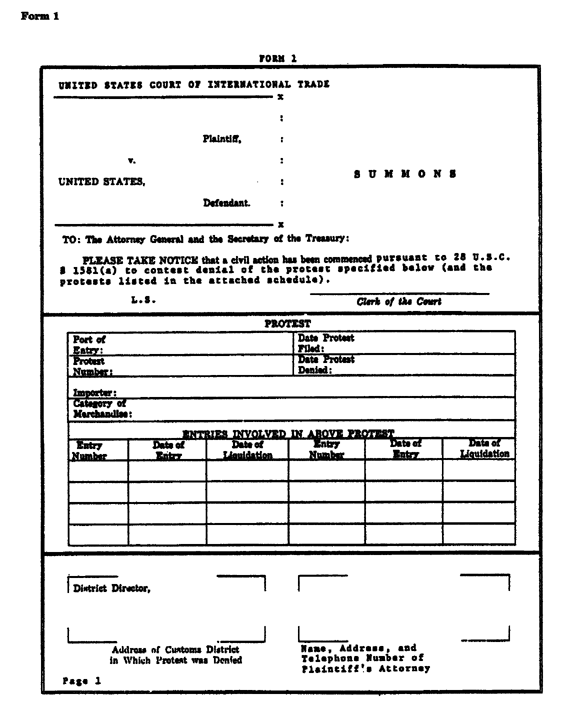
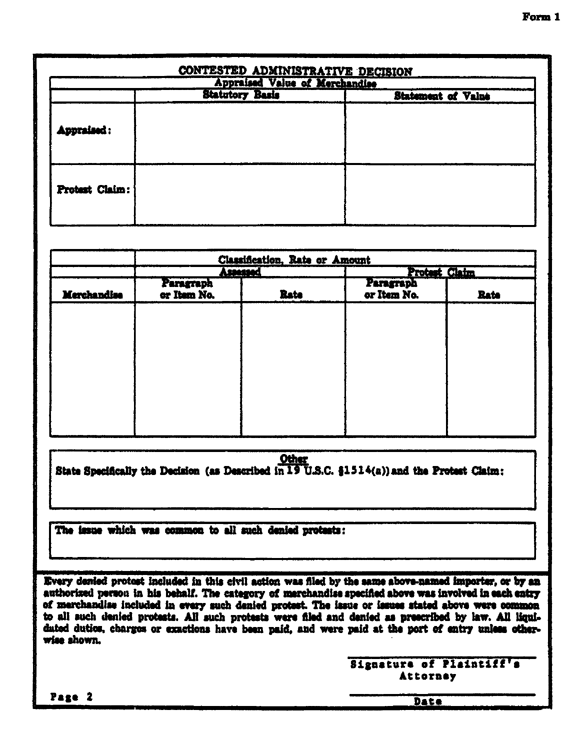
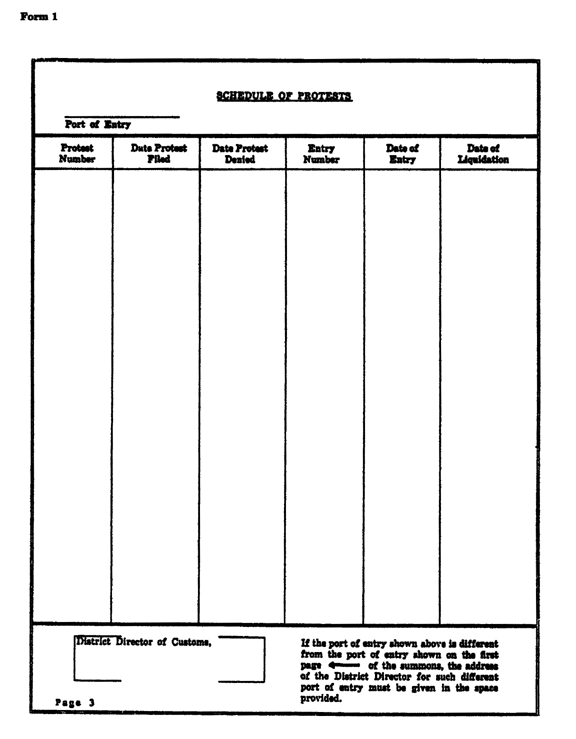
Form 1A
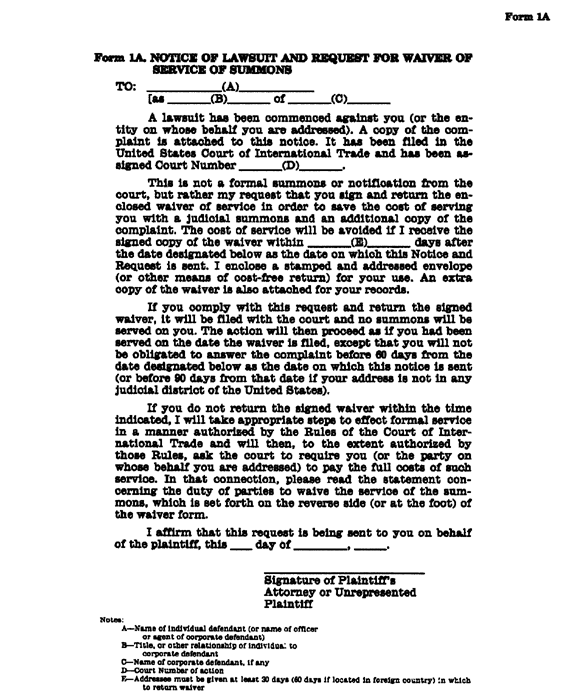
(Added Oct. 5, 1994, eff. Jan. 1, 1995; amended Nov. 14, 1997, eff. Jan. 1, 1998.)
The waiver of service provision under Rule 4(d) does not apply to the United States government. Practitioners also should be aware that failure to waive service in the appropriate circumstances may result in assessment of the costs of service of a summons and complaint.
Form 1B
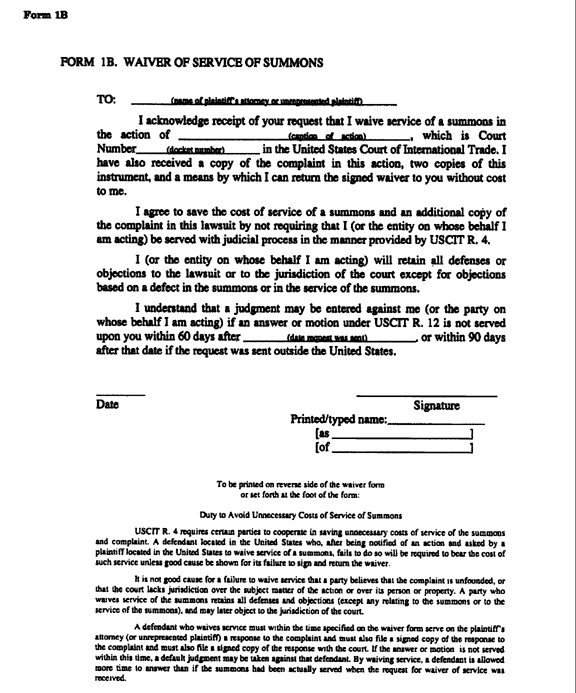
Form 2
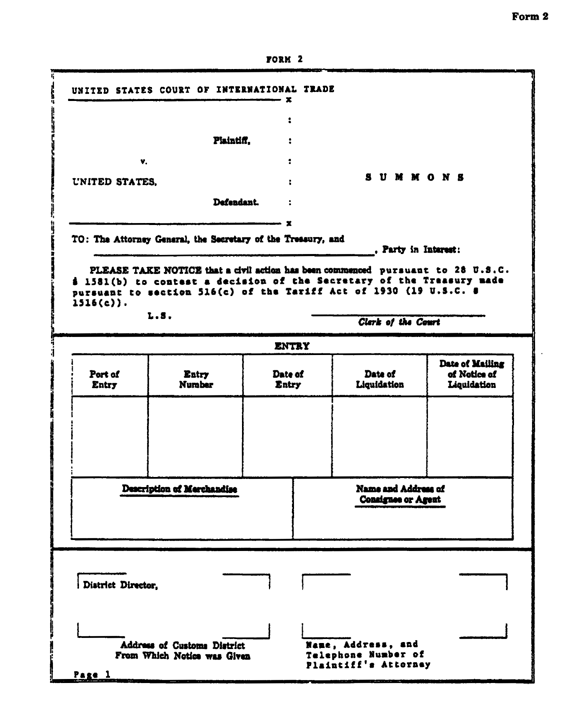
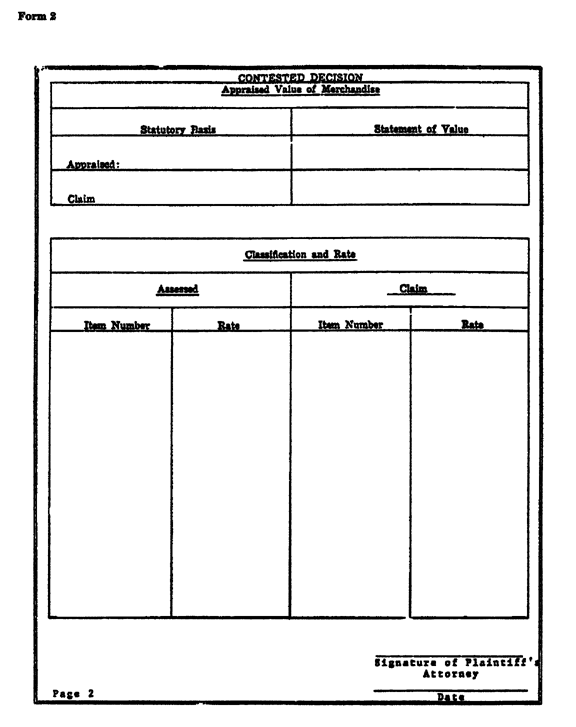
Form 3
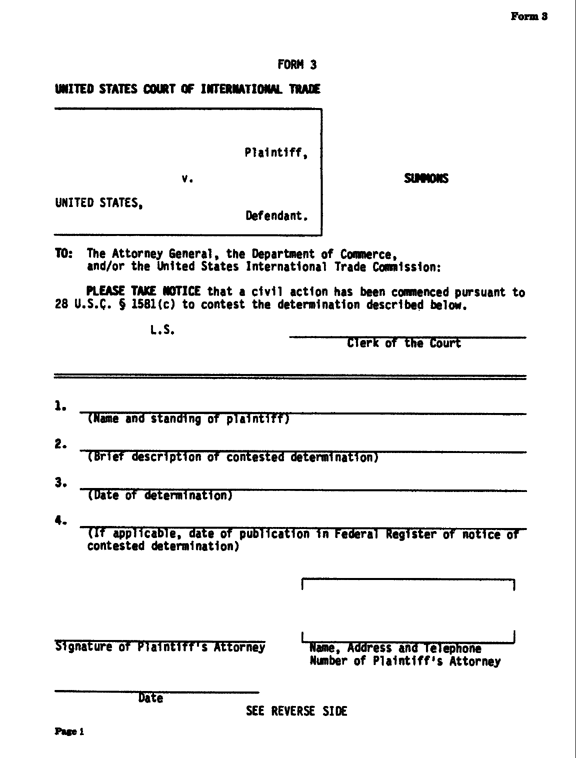
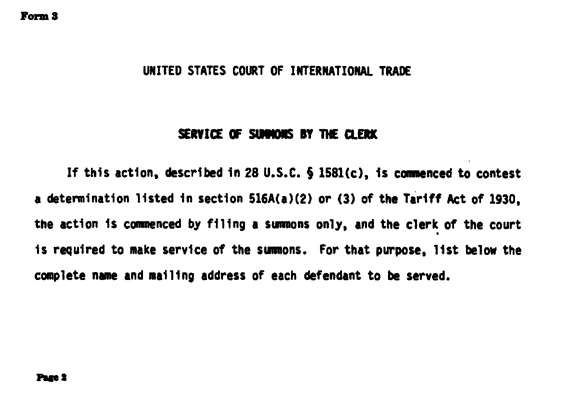
Form 4
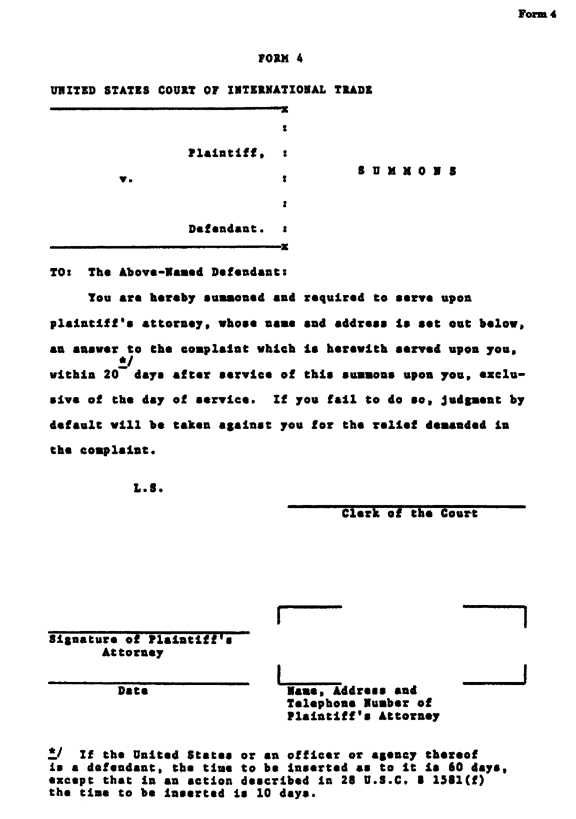
Form 5
[img: 28af5p1 .gif]
[img: 28af5p2 .gif]
Form 6
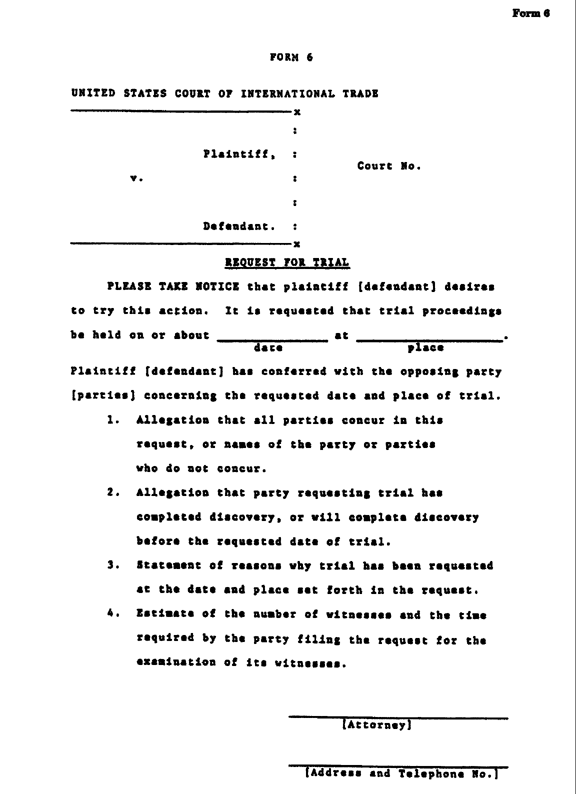
Form 7
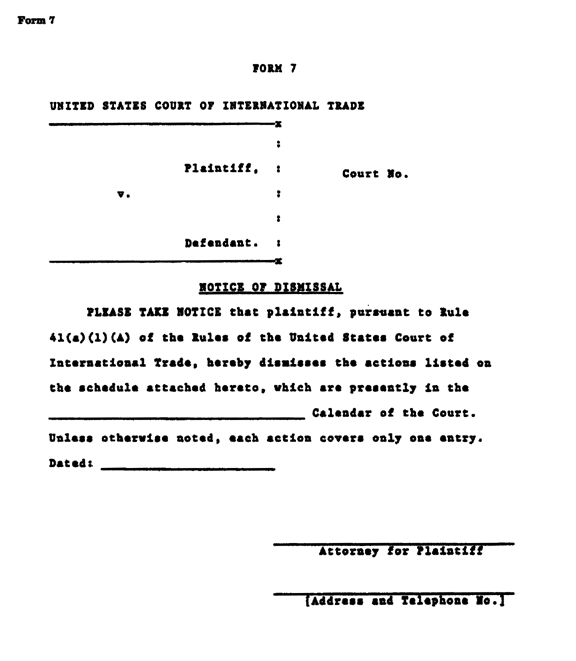
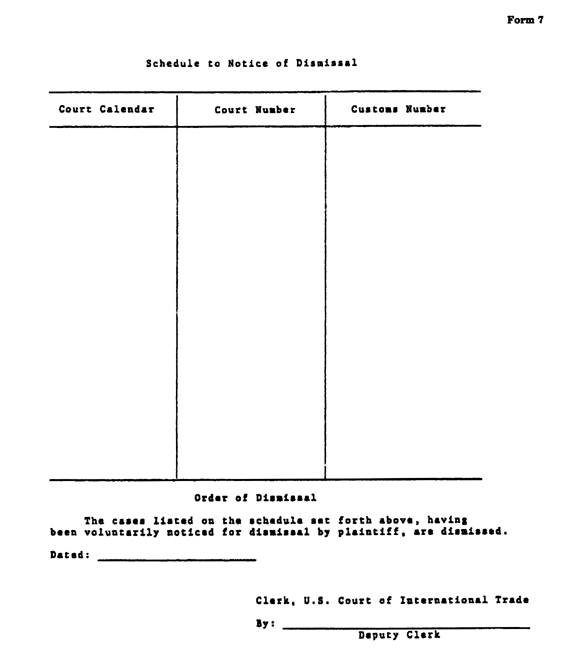
Form 8
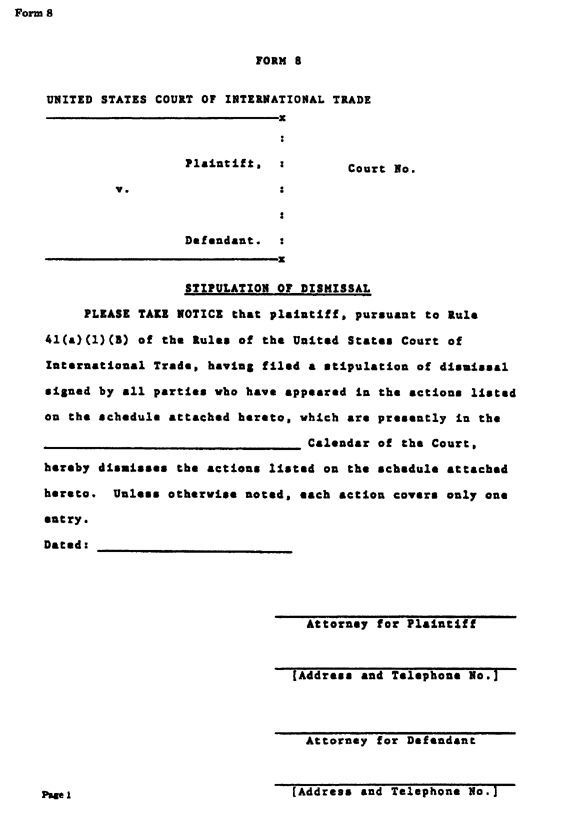
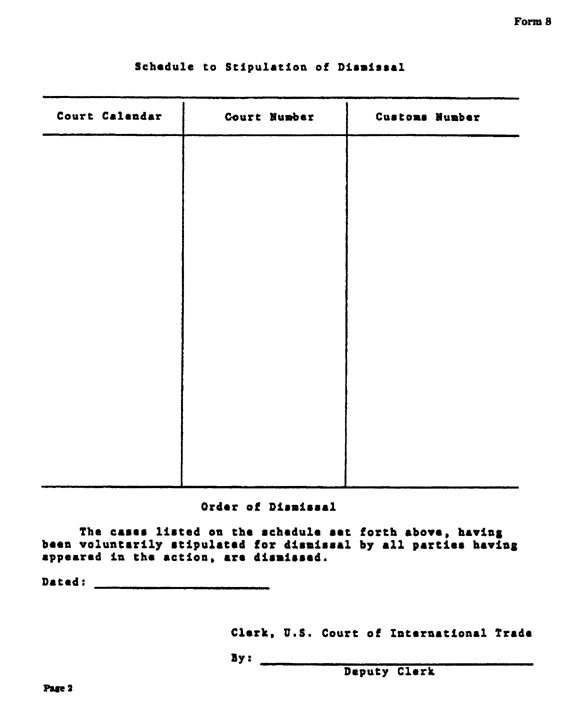
Form 9
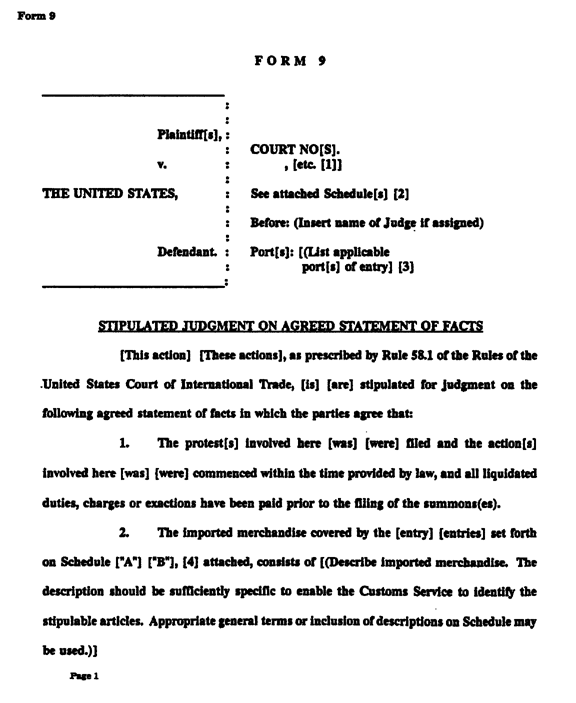
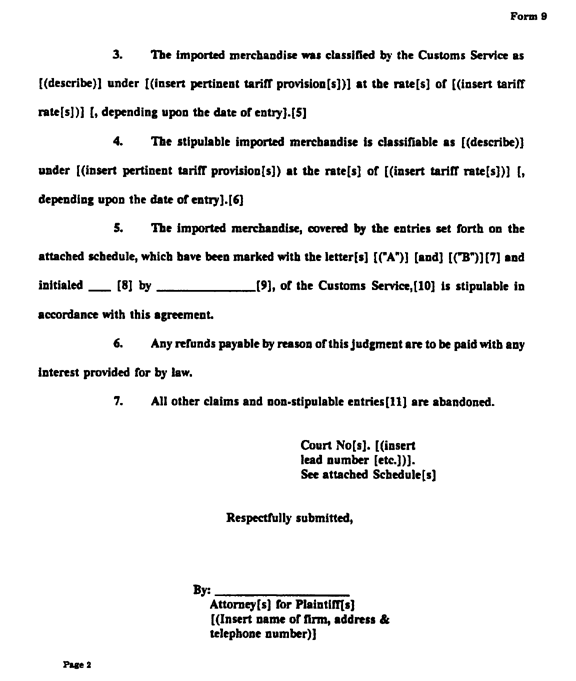
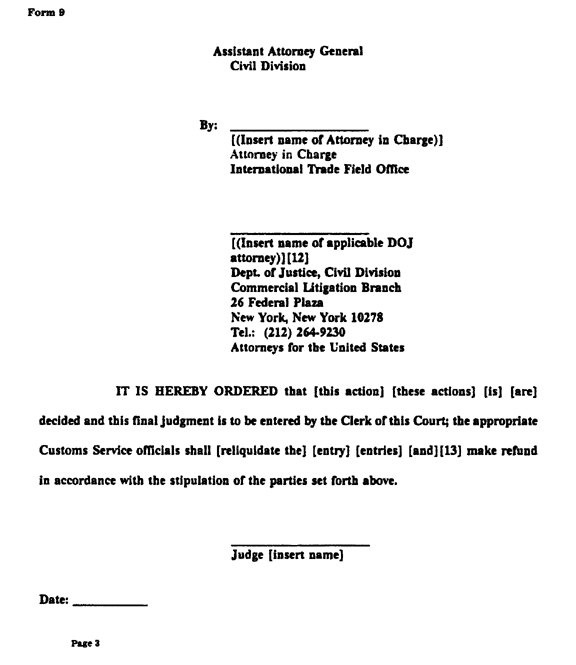
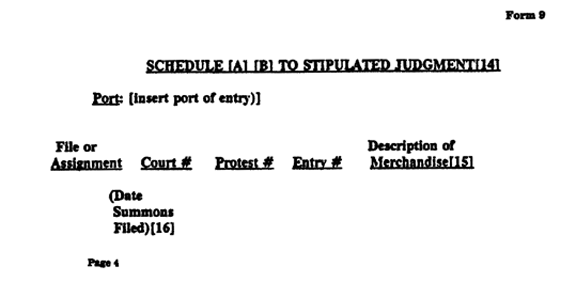
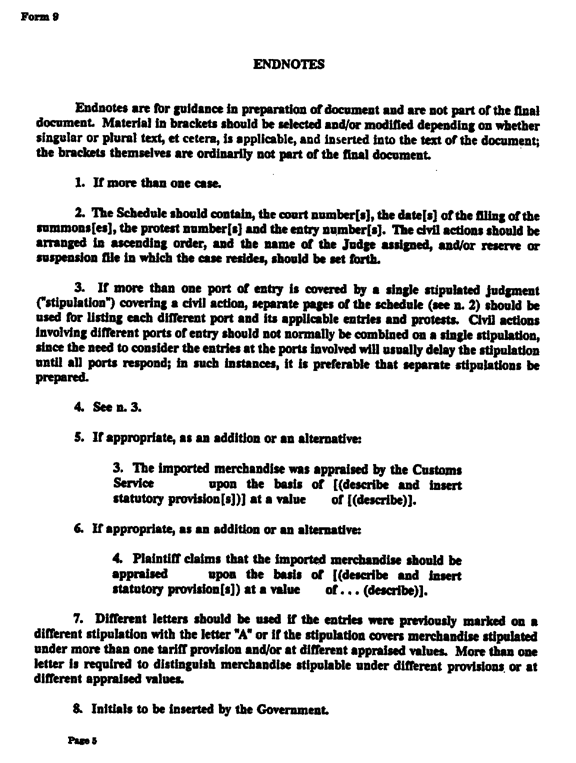
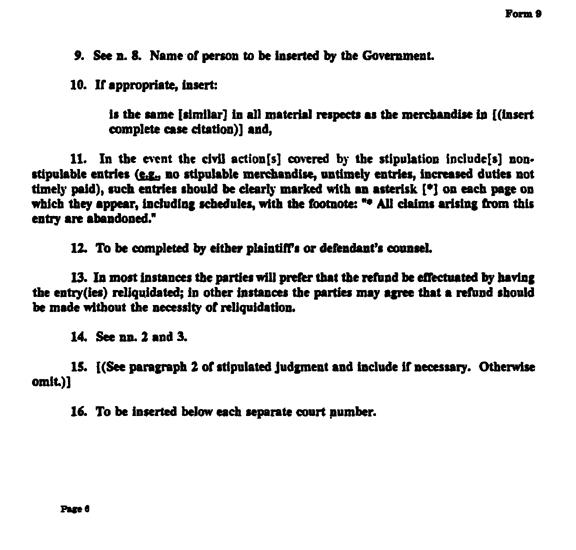
Form 10
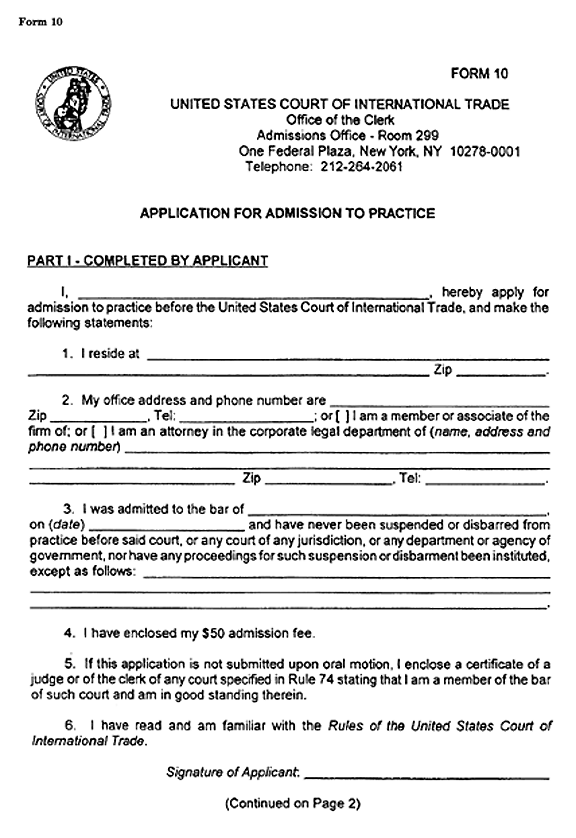
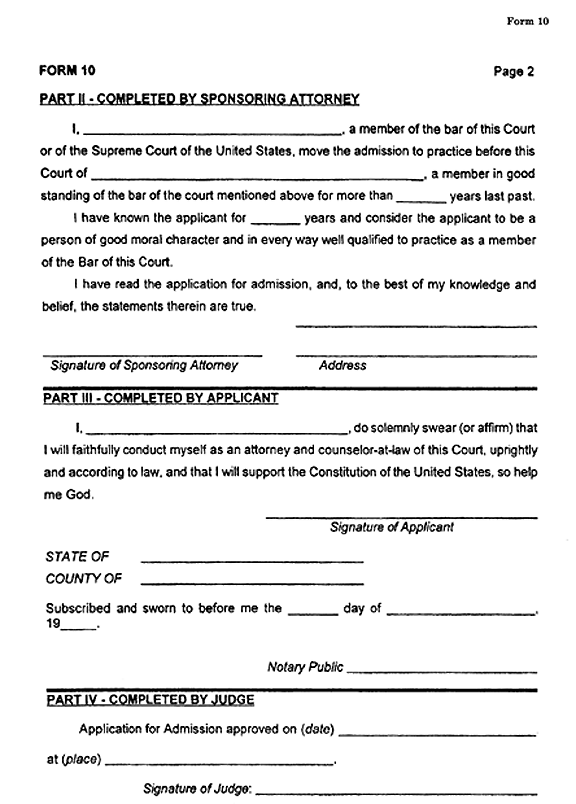
(As amended Nov. 29, 1995, eff. Jan. 1, 1996; Mar. 25, 1998, eff. July 1, 1998.)
Form 11
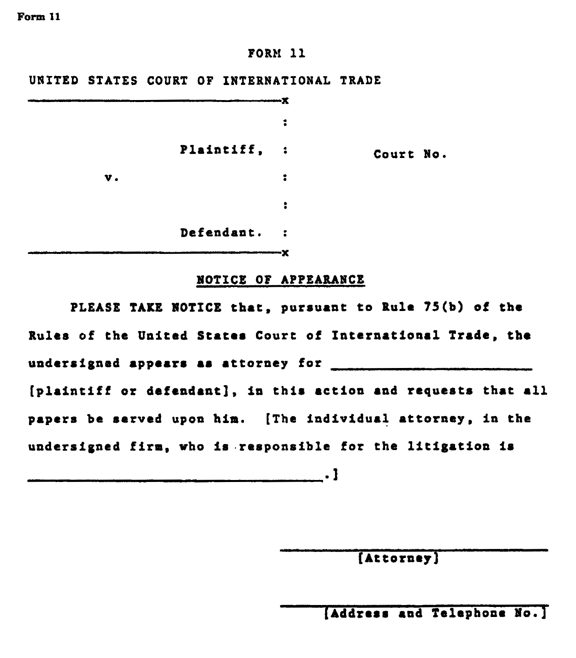
Form 12
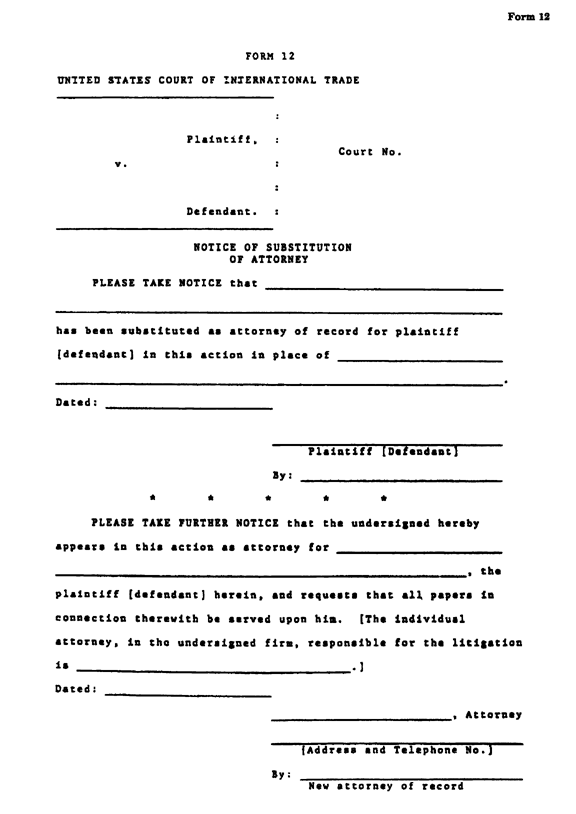
Form 13
Form 14
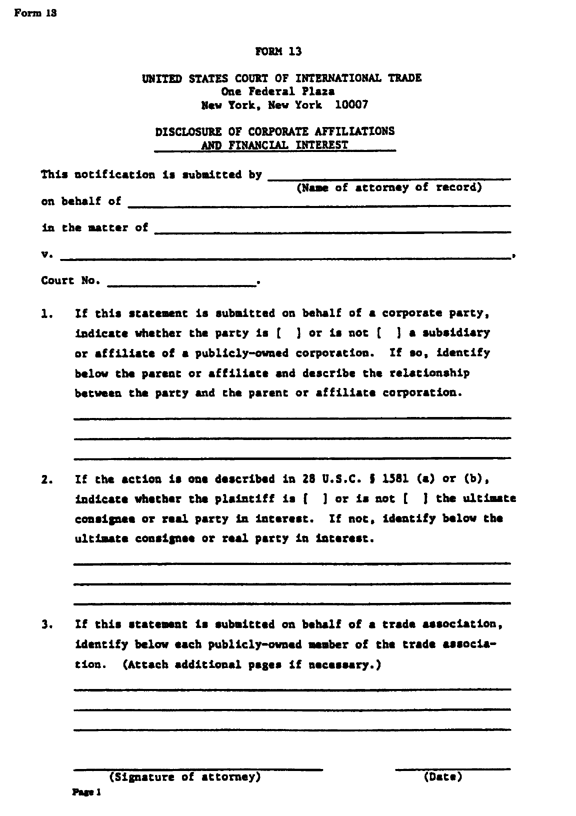
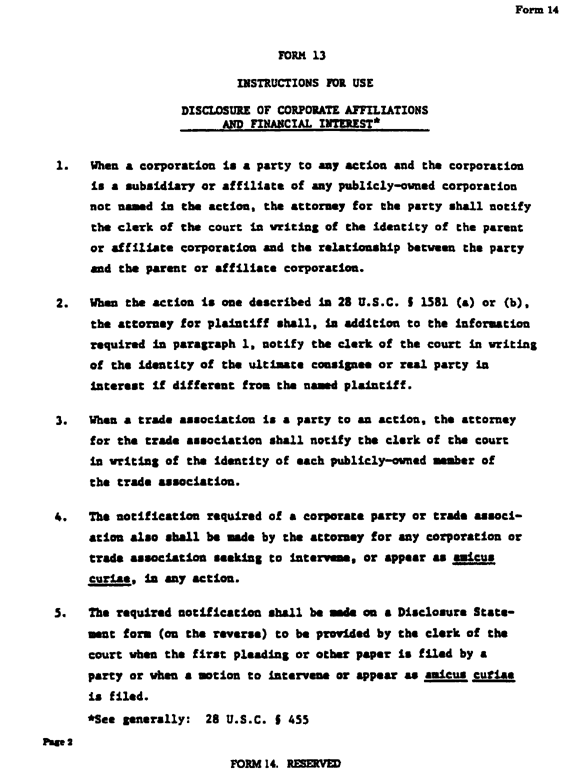
Form 15
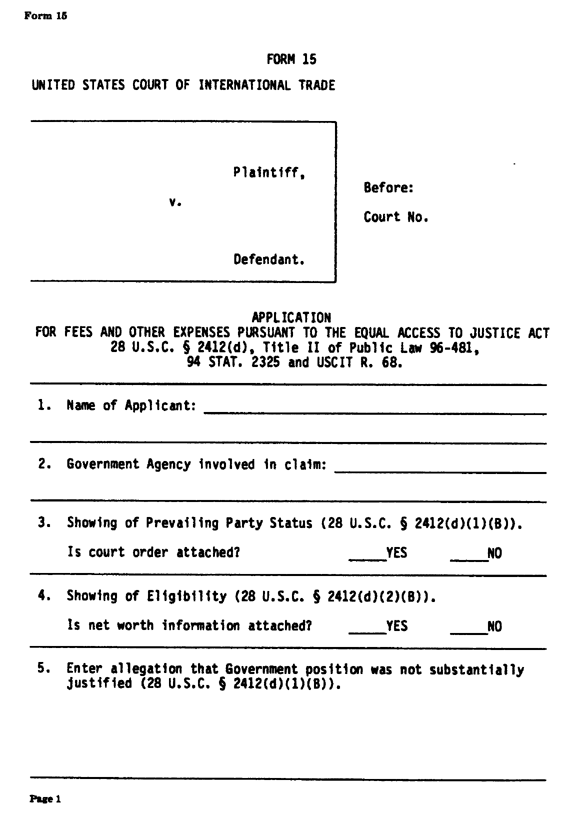
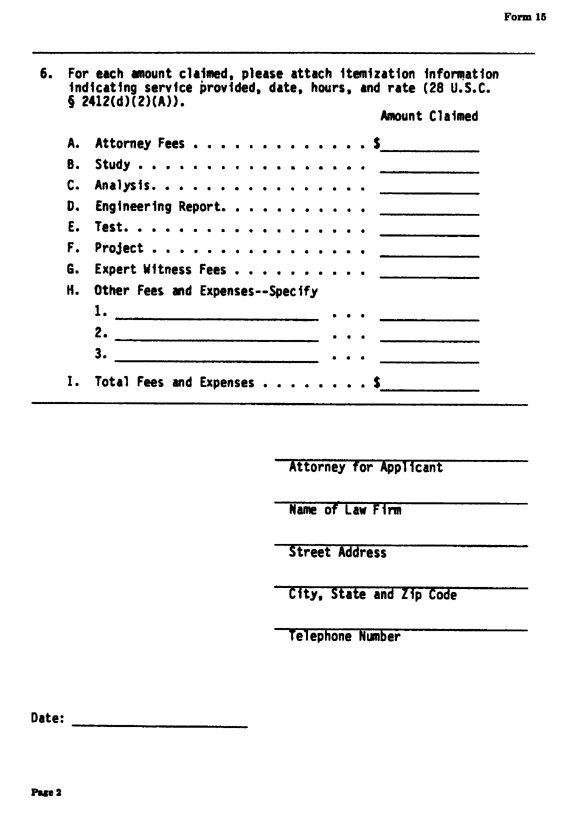
Form 16
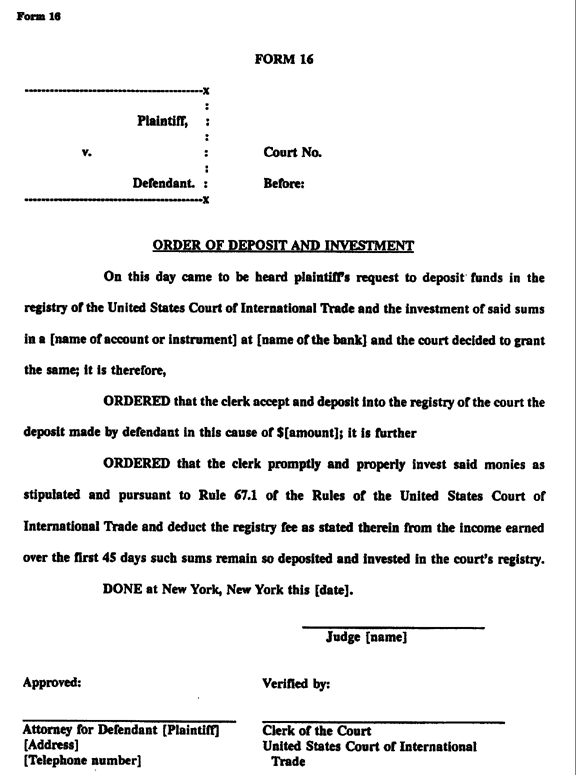
Form 17
[img: 28af17p1 .gif]
[img: 28af17p2 .gif]
[img: 28af17p3 .gif]
[img: 28af17p4 .gif]
Form 18
[img: 28af18p1 .gif]
[img: 28af18p2 .gif]
Form 19
[img: 28af19p1 .gif]
[img: 28af19p2 .gif]